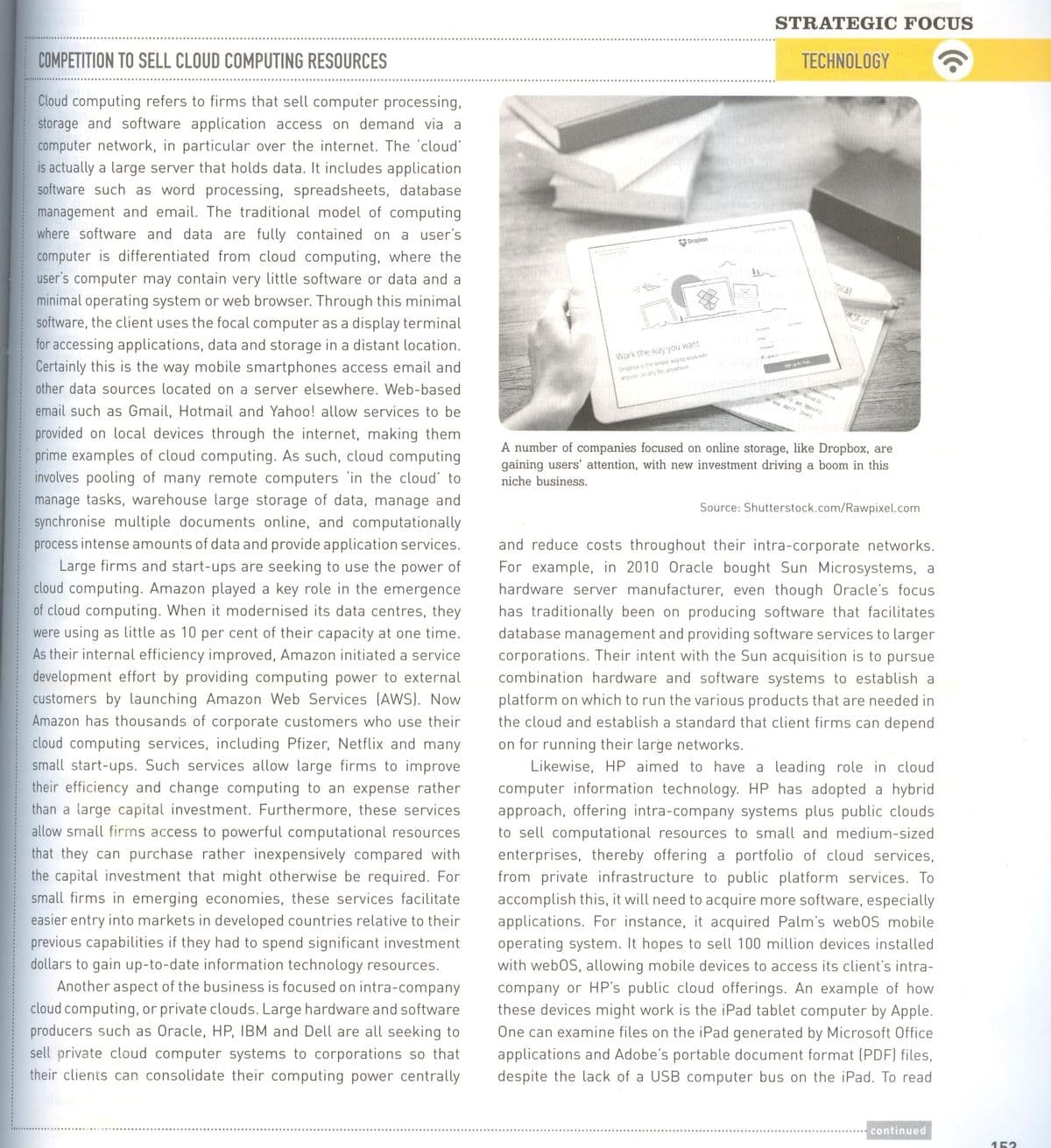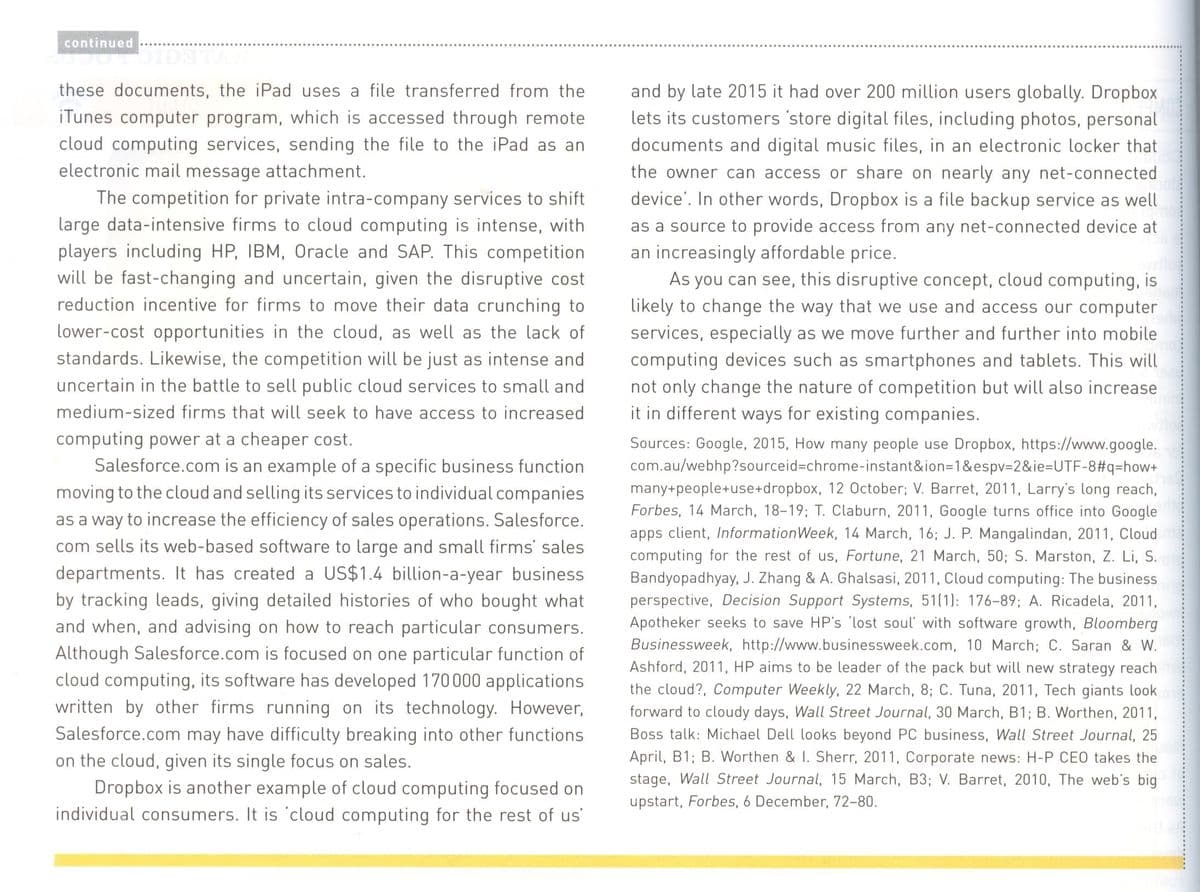how cloud computing will change the nature of competition for many businesses now and in the future
how cloud computing will change the nature of competition for many businesses now and in the future
Fundamentals of Information Systems
8th Edition
ISBN:9781305082168
Author:Ralph Stair, George Reynolds
Publisher:Ralph Stair, George Reynolds
Chapter8: Systems Development
Section: Chapter Questions
Problem 2WE
Related questions
Question
how cloud computing will change the nature of competition for many businesses now and in the future

Transcribed Image Text:STRATEGIC FOCUS
COMPETITION TO SELL CLOUD COMPUTING RESOURCES
TECHNOLOGY
Cloud computing refers to firms that sell computer processing,
storage and software application access on demand via a
computer network, in particular over the internet. The 'cloud'
is actually a large server that holds data. It includes application
software such as word processing, spreadsheets, database
management and email. The traditional model of computing
where software and data are fully contained on a user's
computer is differentiated from cloud computing, where the
user's computer may contain very little software or data and a
minimal operating system or web browser. Through this minimal
software, the client uses the focal computer as a display terminal
for accessing applications, data and storage in a distant location.
Certainly this is the way mobile smartphones access email and
other data sources located on a server elsewhere. Web-based
email such as Gmail, Hotmail and Yahoo! allow services to be
provided on local devices through the internet, making them
prime examples of cloud computing. As such, cloud computing
involves pooling of many remote computers in the cloud' to
manage tasks, warehouse large storage of data, manage and
synchronise multiple documents online, and computationally
process intense amounts of data and provide application services.
Large firms and start-ups are seeking to use the power of
cloud computing. Amazon played a key role in the emergence
of cloud computing. When it modernised its data centres, they
were using as little as 10 per cent of their capacity at one time.
As their internal efficiency improved, Amazon initiated a service
development effort by providing computing power to external
customers by launching Amazon Web Services (AWS). Now
Amazon has thousands of corporate customers who use their
Work the way you want
Droto
A number of companies focused on online storage, like Dropbox, are
gaining users' attention, with new investment driving a boom in this
niche business.
Source: Shutterstock.com/Rawpixel.com
and reduce costs throughout their intra-corporate networks.
For example, in 2010 Oracle bought Sun Microsystems, a
hardware server manufacturer, even though Oracle's focus
has traditionally been on producing software that facilitates
database management and providing software services to larger
corporations. Their intent with the Sun acquisition is to pursue
combination hardware and software systems to establish a
platform on which to run the various products that are needed in
the cloud and establish a standard that client firms can depend
cloud computing services, including Pfizer, Netflix and many
small start-ups. Such
their efficiency and change computing to an expense rather
than a large capital investment. Furthermore, these services
allow small firms access to powerful computational resources
on for running their large networks.
allow large
to improve
aimed to have a leading role in cloud
computer information technology. HP has adopted a hybrid
approach, offering intra-company systems plus public clouds
Likewise,
to sell computational resources to small and medium-sized
that they can purchase rather inexpensively compared with
the capital investment that might otherwise be required. For
small firms in emerging economies, these services facilitate
easier entry into markets in developed countries relative to their
previous capabilities if they had to spend significant investment
dollars to gain up-to-date information technology resources.
Another aspect of the business is focused on intra-company
cloud computing, or private clouds. Large hardware and software
producers such as Oracle, HP, IBM and Dell are all seeking to
enterprises, thereby offering a portfolio of cloud services,
from private infrastructure to public platform services. To
accomplish this, it will need to acquire more software, especially
applications. For instance, it acquired Palm's web0S mobile
operating system. It hopes to sell 100 million devices installed
with web0S, allowing mobile devices to access its client's intra-
company or HP's public cloud offerings. An example of how
these devices might work is the iPad tablet computer by Apple.
sell private cloud computer systems to corporations so that
their clients can consolidate their computing power centrally
One can examine files on the iPad generated by Microsoft 0ffice
applications and Adobe's portable document format (PDF) files,
despite the lack of a USB computer bus on the iPad. To read
continued
16?

Transcribed Image Text:continued
these documents, the iPad uses a file transferred from the
and by late 2015 it had over 200 million users globally. Dropbox
iTunes computer program, which is accessed through remote
cloud computing services, sending the file to the iPad as an
electronic mail message attachment.
The competition for private intra-company services to shift
large data-intensive firms to cloud computing is intense, with
players including HP, IBM, Oracle and SAP. This competition
will be fast-changing and uncertain, given the disruptive cost
reduction incentive for firms to move their data crunching to
lets its customers 'store digital files, including photos, personal
documents and digital music files, in an electronic locker that
the owner can access or share on nearly any net-connected
device'. In other words, Dropbox is a file backup service as well
as a source to provide access from any net-connected device at
an increasingly affordable price.
As you can see, this disruptive concept, cloud computing, is
likely to change the way that we use and access our computer
services, especially as we move further and further into mobile
computing devices such as smartphones and tablets. This will
not only change the nature of competition but will also increase
it in different ways for existing companies.
lower-cost opportunities in the cloud, as well as the lack of
standards. Likewise, the competition will be just as intense and
uncertain in the battle to sell public cloud services to small and
medium-sized firms that will seek to have access to increased
computing power at a cheaper cost.
Salesforce.com is an example of a specific business function
moving to the cloud and selling its services to individual companies
as a way to increase the efficiency of sales operations. Salesforce.
com sells its web-based software to large and small firms' sales
departments. It has created a US$1.4 billion-a-year business
by tracking leads, giving detailed histories of who bought what
and when, and advising on how to reach particular consumers.
Although Salesforce.com is focused on one particular function of
cloud computing, its software has developed 170000 applications
written by other firms running on its technology. However,
Salesforce.com may have difficulty breaking into other functions
on the cloud, given its single focus on sales.
Dropbox is another example of cloud computing focused on
individual consumers. It is 'cloud computing for the rest of us
Sources: Google, 2015, How many people use Dropbox, https://www.google.
com.au/webhp?sourceid%-chrome-instant&ion=1&espv-2&ie%3DUTF-8#q=how+
many+people+use+dropbox, 12 0ctober; V. Barret, 2011, Larry's long reach,
Forbes, 14 March, 18-19; T. Claburn, 2011, Google turns office into Google
apps client, InformationWeek, 14 March, 16; J. P. Mangalindan, 2011, Cloud
computing for the rest of us, Fortune, 21 March, 50; S. Marston, Z. Li, S.
Bandyopadhyay, J. Zhang & A. Ghalsasi, 2011, Cloud computing: The business
perspective, Decision Support Systems, 51(1): 176-89; A. Ricadela, 2011,
Apotheker seeks to save HP's 'lost soul' with software growth, Bloomberg
Businessweek, http://www.businessweek.com, 10 March; C. Saran & W.
Ashford, 2011, HP aims to be leader of the pack but will new strategy reach
the cloud?, Computer Weekly, 22 March, 8; C. Tuna, 2011, Tech giants look
forward to cloudy days, Wall Street Journal, 30 March, B1; B. Worthen, 2011,
Boss talk: Michael Dell looks beyond PC business, Wall Street Journal, 25
April, B1; B. Worthen & I. Sherr, 2011, Corporate news: H-P CEO takes the
stage, Wall Street Journal, 15 March, B3; V. Barret, 2010, The web's big
upstart, Forbes, 6 December, 72-80.
Expert Solution
This question has been solved!
Explore an expertly crafted, step-by-step solution for a thorough understanding of key concepts.
This is a popular solution!
Trending now
This is a popular solution!
Step by step
Solved in 3 steps

Knowledge Booster
Learn more about
Need a deep-dive on the concept behind this application? Look no further. Learn more about this topic, computer-science and related others by exploring similar questions and additional content below.Recommended textbooks for you

Fundamentals of Information Systems
Computer Science
ISBN:
9781305082168
Author:
Ralph Stair, George Reynolds
Publisher:
Cengage Learning

Principles of Information Systems (MindTap Course…
Computer Science
ISBN:
9781285867168
Author:
Ralph Stair, George Reynolds
Publisher:
Cengage Learning

Fundamentals of Information Systems
Computer Science
ISBN:
9781337097536
Author:
Ralph Stair, George Reynolds
Publisher:
Cengage Learning

Fundamentals of Information Systems
Computer Science
ISBN:
9781305082168
Author:
Ralph Stair, George Reynolds
Publisher:
Cengage Learning

Principles of Information Systems (MindTap Course…
Computer Science
ISBN:
9781285867168
Author:
Ralph Stair, George Reynolds
Publisher:
Cengage Learning

Fundamentals of Information Systems
Computer Science
ISBN:
9781337097536
Author:
Ralph Stair, George Reynolds
Publisher:
Cengage Learning

Database Systems: Design, Implementation, & Manag…
Computer Science
ISBN:
9781285196145
Author:
Steven, Steven Morris, Carlos Coronel, Carlos, Coronel, Carlos; Morris, Carlos Coronel and Steven Morris, Carlos Coronel; Steven Morris, Steven Morris; Carlos Coronel
Publisher:
Cengage Learning

Database Systems: Design, Implementation, & Manag…
Computer Science
ISBN:
9781305627482
Author:
Carlos Coronel, Steven Morris
Publisher:
Cengage Learning